The Asia-Pacific region; the OneNPWT clinical decision tree for open wounds

The prevalence of wounds is increasing globally, particularly in the Asia-Pacific (APAC) region. The International Diabetes Federation (IDF) estimates that there were 537 million people with diabetes worldwide in 2021, and up to one-third of those individuals will experience a diabetic foot ulcer (DFU) during their lifetime (Nair et al, 2022). The high prevalence of […]
Incision care and dressing selection in surgical wounds: Findings from a series of international meetings
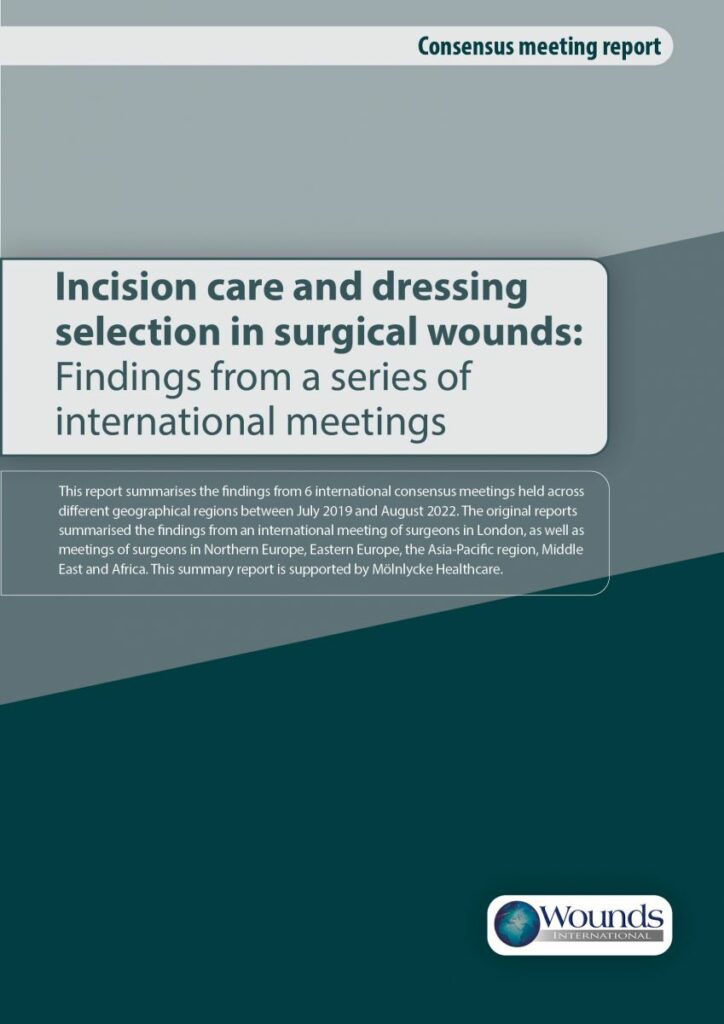
This report summarises the findings from 6 international consensus meetings held across different geographical regions between July 2019 and August 2022. The original reports summarised the findings from an international meeting of surgeons in London, as well as meetings of surgeons in Northern Europe, Eastern Europe, the Asia-Pacific region, Middle East and Africa. This summary […]
Debridement and healing time reduction for chronic venous ulcers in patients treated with topical application of Ozoile and compression therapy

This paper reports a randomised clinical trial of 81 patients with phlebostatic ulcers of the lower limbs who underwent treatment with topical application of Ozoile. The results were compared with a control group which did not receive the treatment. The trial lasted 9 months overall. Over this period of time, patients treated with Ozoile showed […]
Incision care and dressing selection in surgical incision wounds: Findings from an international meeting of surgeons from Africa

This report highlights the findings of a meeting of clinicians based in Africa to discuss incision care and dressing selection for clean surgical incisions closed with primary intention. The meeting was held in Johannesburg, South Africa, in August 2022, and chaired by Associate Professor Kylie Sandy-Hodgetts (Australia).
Management of burn wounds by a technology lipido-colloid polyacrylate dressing impregnated with silver: a case series from Vietnam

Burn injuries are a mostly avoidable trauma that affect millions of people worldwide every year. Wound healing in burn patients is complex, and infection is one of the main clinical complications associated with wound care in burn patients. Biofilms are mostly associated with chronic wounds, but have also been identified in acute, traumatic wounds. This […]
Digest: 13-4

In this section, we present brief synopses of a range of recently published articles that may be of interest to healthcare professionals working in the wound care setting. The aim of this round-up is to provide an overview, rather than a detailed summary and critique, of the research papers selected. Full references are provided should […]
Negative pressure wound therapy on a lactating breast: a case that demonstrates it can be achieved

Negative pressure wound therapy (NPWT) is common after debridement of necrotic tissue post mastitis, when a gaping wound needs to be treated, but there is limited scientific evidence on the use of NPWT on the lactating breast. Patients are sent home with an open wound draining pus and milk, information on self care, and often […]
Implementation of the M.O.I.S.T. concept for the local treatment of chronic wounds into clinical practice
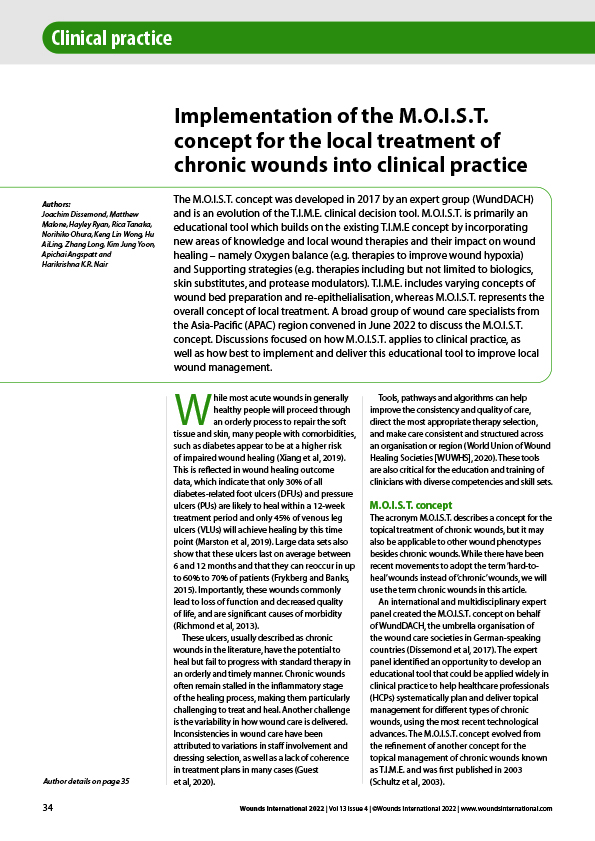
The M.O.I.S.T. concept was developed in 2017 by an expert group (WundDACH) and is an evolution of the T.I.M.E. clinical decision tool. M.O.I.S.T. is primarily an educational tool which builds on the existing T.I.M.E concept by incorporating new areas of knowledge and local wound therapies and their impact on wound healing – namely Oxygen balance […]
The shared wound care continuum: factors that influence a patient’s preference and suitability for shared wound care

Shared wound care encompasses practice interventions that facilitate interested and capable patients to take a more active role in care planning and delivery, such as the monitoring and changing of dressings. Clinicians report that up to 45% of patients may be suitable for shared wound care approaches, and up to 51% may be willing. This […]
Read the WHOLE research paper

My clinical students submit a research paper each week that is relevant to their current patient. A student was caring for a patient with heart failure in the intensive care unit and submitted a paper that discussed the benefits of exercise for patients with a similar condition. She chose a nice paper in the references […]
Ten top tips: arterial/ischaemic wounds

Peripheral arterial disease (PAD) is chronic occlusive atherosclerosis (ASO) that limits arterial blood flow to the lower extremities. It is a manifestation of systemic atherosclerosis. Arterial ulcers, also known as ischaemic ulcers or ischemic wounds, develop as the result of a lack of blood flow to tissue. It is estimated that over 200 million people […]
The efficacy of non-thermal gas plasma in the treatment of diabetic foot ulcers stalled by subclinical, biofilm-related wound infection

New concepts and strategies for managing wound infection, biofilm and impaired wound healing are urgently needed. This study examines the effects of non-thermal gas plasma (NTGP) in the management of diabetic foot ulcers stalled by subclinical, biofilm-related wound infection. Patients either received local standard of care or standard care plus 5 minutes NTGP twice weekly). […]
Cost-effectiveness of wound treatment with cyanoacrylate topical adhesive in primary health care units in a region of Portugal

The study focuses on the cost-effectiveness analysis of wound treatment with cyanoacrylate topical adhesive, skin glue. A descriptive, exploratory, cross-sectional study with a convenience sample was used to analyse the effectiveness and annual direct cost of using N-butyl-2-cyanoacrylate topical adhesive in simple wounds in primary health care units in the Algarve region of Portugal. These […]
Application of polyurethane foam dressing at split-thickness skin graft recipient site in patients with diabetic wounds: a case series

Aim: To investigate use of an advanced polyurethane foam dressing for recipient site wound healing after a split-thickness skin graft (STSG) for diabetic wound closure. Methods: Graft viability, ease of use of the dressing, exudate management and wound infection status were assessed in 18 patients who underwent a STSG for diabetic wound closure and postoperative […]
Made Easy: Wound Infection in Clinical Practice
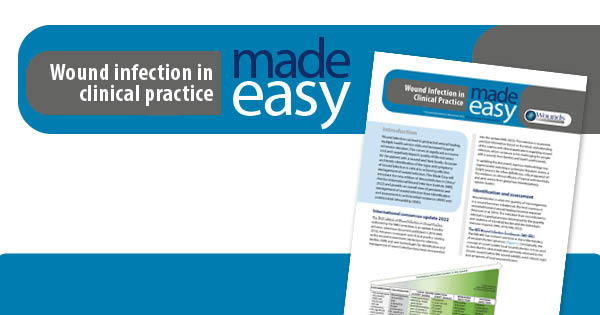
Wound infection can lead to protracted wound healing, multiple health service visits and increased hospital admission duration. This comes at significant economic cost and negatively impacts quality of life outcomes for the patient with a wound and their family. Accurate and timely identification of the signs and symptoms of wound infection is critical to achieving […]
Patients presenting with ‘Red Legs’: Different diagnosis and the role of compression

Patients presenting with lower limb redness are often diagnosed with lower limb cellulitis and are frequently treated with antibiotic therapy. Cellulitis is a common condition presenting as an acute inflammation or redness of the skin and subcutaneous tissue, as a result of bacterial infection, hence the term ‘red legs’. Although infection causes inflammation, it is […]
International Consensus Document: Diabetic foot ulcer care in the Asia-Pacific region

The global prevalence of diabetes and diabetic foot ulcers (DFUs) is increasing, with growing threat of morbidity, amputation and mortality. In the Asia-Pacific (APAC) region, this issue is particularly urgent. The International Diabetes Federation (IDF) estimates that there were 537 million people living with diabetes globally in 2021, and that this number will increase to […]
Closed incision negative pressure wound therapy: A literature review and an introduction to Avance® Solo

Wounds that result from surgical interventions should, in theory, present less of a clinical challenge than other types of wounds as they are generally ‘clean’ and formed by pre-determined incidents. However, despite many advances in the technologies and techniques used in the pre-, intra- and post-operative phases of patient care, surgical site complications continue to […]
Ten top tips: intertrigo/intertriginous dermatitis

Intertrigo or intertriginous dermatitis is an inflammatory condition of skin folds, induced or aggravated by heat, moisture, maceration, friction and lack of air circulation. Intertrigo’s Latin translation, inter (between) and terere (to rub) helps explain the pathophysiology of the condition.
Copaiba oleoresin activity against prevalent microorganisms in chronic wound infections

Background: Chronic wounds with excess bacteria present an increasing worldwide health problem. These wounds are difficult to heal, presenting prolonged inflammation and recurring microbial infections. Copaiba oleoresin (Copaifera multijuga Hayne) is a substance rich in sesquiterpenes and diterpenes, facilitating cicatrisation (the contraction of fibrous tissue formed at the site of a wound by fibroblasts, which […]
Case studies from the perspectives of aged care residents on turning and positioning: Implications for technical progress in pressure injury prevention

The perspectives of aged care residents on turning and positioning is required to improve care and prevent pressure injuries. The following case studies share aged care resident perspectives and satisfaction with turning and positioning devices and equipment. Key learnings include the need for tailored turning and positioning care for diverse aged care residents; the benefits […]
Recombinant human collagen: case studies of a new solution for atypical refractory ulcers
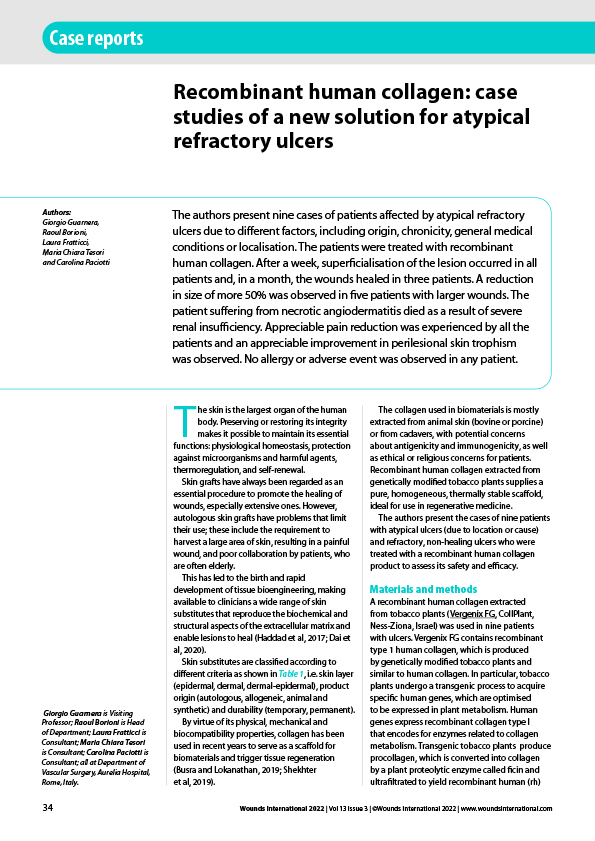
The authors present nine cases of patients affected by atypical refractory ulcers due to different factors, including origin, chronicity, general medical conditions or localisation. The patients were treated with recombinant human collagen. After a week, superficialisation of the lesion occurred in all patients and, in a month, the wounds healed in three patients. A reduction […]
Wounds digest

In this section, a brief synopsis is presented of a range of recently published articles that may be of interest to healthcare professionals working in the wound care setting. The aim of this round-up is to provide an overview, rather than a detailed summary and critique, of the research papers selected. Full references are provided […]
Know your accomplice

I like crime drama, so perhaps I lean toward thinking about crime more than you do. However, I think the bedside chair has become an accomplice to pressure injury formation. Here is what I am seeing…
Incision care and dressing selection in surgical incision wounds: Findings from an international meeting of surgeons from the Middle East

This report highlights the findings of a meeting of clinicians based in the Middle East to discuss incision care and dressing selection for elective, clean surgical incisions closed with primary intention. The meeting was held in Dubai, United Arab Emirates, in July 2022, and co-chaired by Dr Mohamed Muath Adi (UAE) and Associate Professor Kylie […]
Excellence in diabetic foot ulcer management: accelerate healing with topical oxygen therapy

Oxygen is needed in every phase of wound healing; however, chronic wounds are often hypoxic. Topical oxygen therapy (TOT) is an intervention that can be used to improve oxygen saturation in the wound bed and support healing, especially in the management of hard-to-heal wounds, such as diabetic foot ulcers, venous leg ulcers and pressure ulcers. […]
Barriers and enablers Barriers and enablers for clinical management of surgical wound complications: results of an international survey prior and during the COVID-19 pandemic

Clinical management of surgical wound complications pose considerable challenges globally. Variations in the use of care bundles for prevention is still widespread in clinical practice. As part of the not-for-profit International Surgical Wound Complications Advisory Panel (ISWCAP) advocacy and research, two international surveys of clinicians were conducted during 2019 and 2021. The survey highlighted the […]
Evolving Challenges in Eschar Removal in the Treatment of Severe Burns: A Roundtable disscussion
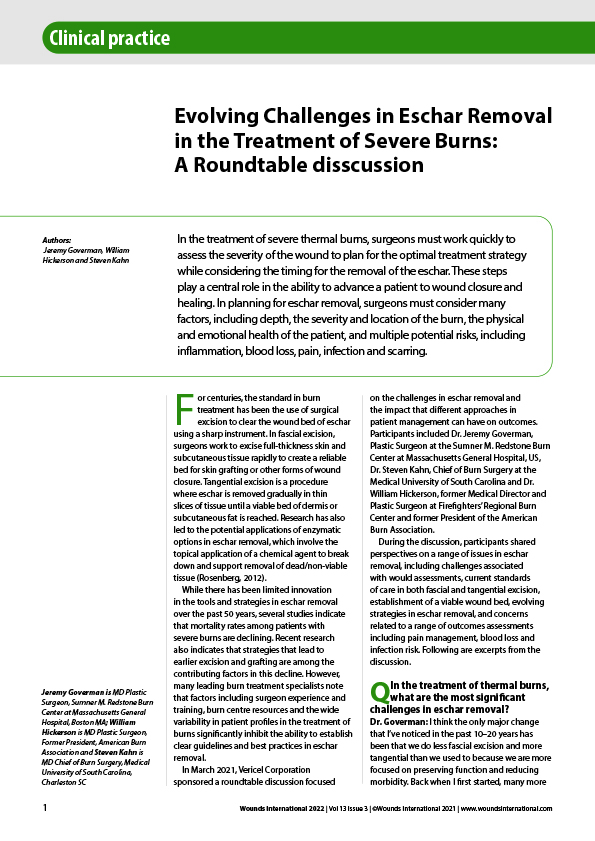
In the treatment of severe thermal burns, surgeons must work quickly to assess the severity of the wound to plan for the optimal treatment strategy while considering the timing for the removal of the eschar. These steps play a central role in the ability to advance a patient to wound closure and healing. In planning […]
The Wound Care Pathway: a potential solution to the global wound care challenge

A symposium titled ‘The Wound Care Pathway: a potential solution to the global wound care challenge’ was held at the European Wound Management Association (EWMA) conference in Paris, France, in May 2022. The symposium addressed the clinical challenges experienced by clinicians caring for people with chronic wounds. The Wound Care Pathway was developed by clinicians […]
Prospective surveillance, prophylactic treatment and proactivity, and… problems solved?

Our lymphoedema and lymphatic failure detection strategies and tools are wide ranging, and have good reliability and accuracy. O!en, however, when they are used to assess the subclinical and early stages of lymphoedema, we may be missing out on a key piece of information (i.e. how did the limb/limbs present prior to the intervention), which […]
Evidence-based practice or practice-based evidence? Why pursuing level 1 evidence is leaving lymphoedema behind

Randomised controlled trials (RCT) have been held as the pinnacle of evidence for health interventions for over half a century and are frequently used in research on lymphedema, yet little in lymphoedema management is suited to an RCT. Nevertheless, multiple systematic reviews (SR) have been conducted, delivering results which are sometimes at odds with clinical […]
Lymphoedema therapist practice, then and now: 2009–2018 international survey results

The American Lymphedema Framework Project (ALFP) collected online survey data from trained lymphoedema therapists in 2009 (nationally) and 2018 (internationally) to document characteristics of therapists’ practice, population served, settings and educational preparation. Comparative analysis of data between survey years was completed to explore changes in the field. Therapists’ mean age increased significantly, as did years […]
Does lipoedema mimic pregnancy?

In recent years, more attention is being paid to the hormonal aspect of lipoedema. There are suggestions that lipoedema patients may have particular imbalances or sensitivities with regard to oestrogens and/or progesterone. This article examines the specifics of gluteofemoral fat storage during pregnancy: increased gluteofemoral storage with strong resistance to lipolysis. It then asks if […]
Patient recall and retention of lymphoedema-linked education knowledge following breast cancer surgery in Australia

Introduction: Education on lymphoedema and lymphoedema risk is an essential part of the cancer care package. This study evaluated recall and retention of lymphoedema-linked education knowledge in patients following breast cancer surgery. Method: Seventy participants at risk of developing lymphoedema were assigned to a 1:1 or group education programme. Surveys captured self-reported recall of their […]
Climate change and climatic variation impact on chronic oedemas: a protocol for a systematic review
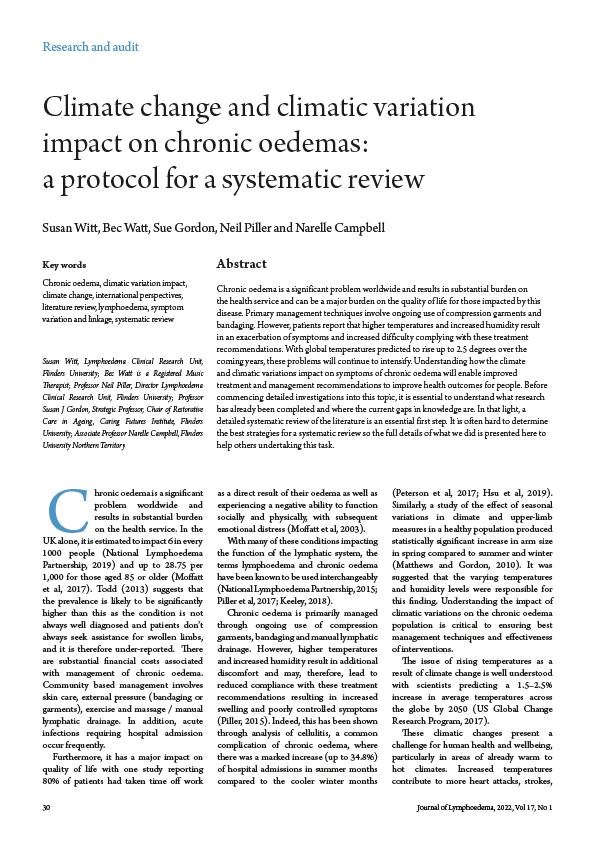
Chronic oedema is a significant problem worldwide and results in substantial burden on the health service and can be a major burden on the quality of life for those impacted by this disease. Primary management techniques involve ongoing use of compression garments and bandaging. However, patients report that higher temperatures and increased humidity result in […]
Outpatient management of secondary upper-limb lymphoedema with an adjustable compression sleeve: a case study

Introduction: Compression bandaging is a key component of complex decongestive therapy (CDT) for lymphoedema (Sezgin Ozcan et al, 2018) and there is increasing interest in using adjustable compression wraps for lymphoedema treatment (!omas, 2017). Objective: To assess the feasibility of using an adjustable compression wrap in the intensive phase of secondary lymphoedema treatment. Methods: A […]
Complex lower-limb lymphatic drainage in a patient with Non-Hodgkin’s lymphoma impacting left inguinal lymph nodes: a case study
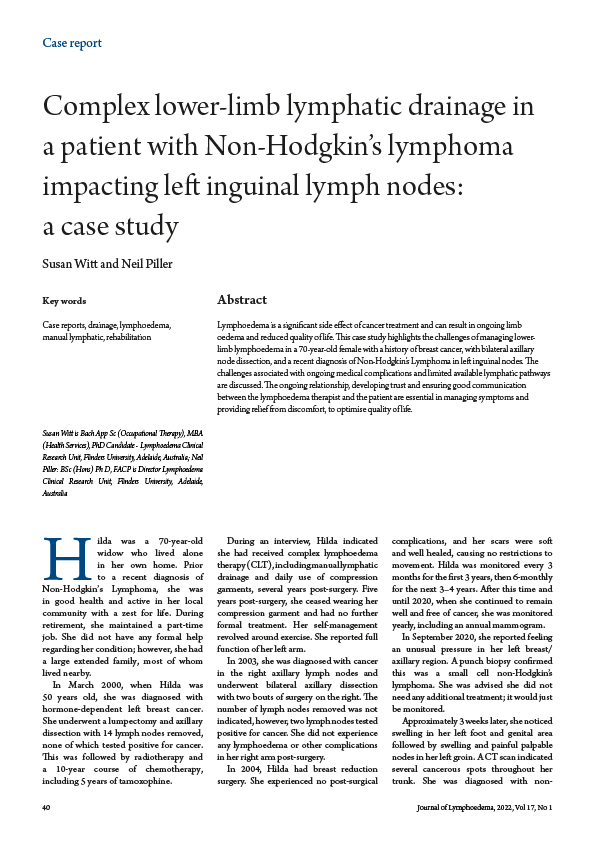
Lymphoedema is a significant side effect of cancer treatment and can result in ongoing limb oedema and reduced quality of life. This case study highlights the challenges of managing lowerlimb lymphoedema in a 70-year-old female with a history of breast cancer, with bilateral axillary node dissection, and a recent diagnosis of Non-Hodgkin’s Lymphoma in left […]
Lymphovenous bypass surgery for the treatment of Kaposi sarcoma-associated lymphoedema

Lymphoedema is a sequela of Kaposi sarcoma (KS) that often does not respond adequately to chemoradiotherapy and complete decongestive therapy (CDT). Lymphovenous bypass (LVB) is an option for patients whose lymphedema persists despite conservative treatment. We present the case of a 59-year-old man with a diagnosis of KS due to human immunodeficiency virus (HIV), who […]
“Highest common denominator”: is it (yet) time to ‘green light’ a be!er ‘hook’ for “the cause” … a perspective anew?

“!e great aim of education is not knowledge but action” ” Herbert Spencer, 19th century English sociologist, philosopher and advocate …!And therein lies the proverbial “rub”, where lymphology, lymphatics, plus “the cause” of the “ght versus lymphatic diseases (LD), including lymphedema (LE) are concerned.
Case series: Shared wound care discussion guide

Shared care encompasses approaches and interventions that may enable patients to participate in care planning, decision making and care delivery. This approach values the patient as an active participant rather than a passive recipient of care, and is a key part of management for a range of other conditions (Wounds International, 2016). Patient involvement can […]
Ten top tips: Wound irrigation

Irrigation of wounds has been shown to aid in removal of wound and dressing debris. Saline cleansing of pressure injury was recommended in 1994 when the first Agency for Health Care Policy and Research (AHCPR) guidelines on treatment were published (Bergstrom et al, 1994). The recommended method used a 35ml syringe and an angiocath to […]
Antibacterial activity of silver sulfadiazine against Streptococcus pyogenes

Beta-haemolytic Streptococcus is a Gram-positive microorganism that is found in burn wounds and provokes graft failure. Streptococcus pyogenes toxins increase the depth and severity of burn wounds. Topical antimicrobial agents can be used to treat burn wounds and improve results after burn infection. However, there are few studies exploring the antimicrobial action of silver sulfadiazine against S pyogenes. This study […]
Does lipoedema mimic pregnancy?

In recent years, more attention is being paid to the hormonal aspect of lipoedema. There are suggestions that lipoedema patients may have particular imbalances or sensitivities with regard to oestrogens and/ or progesterone. This article examines the specifics of gluteofemoral fat storage during pregnancy: increased gluteofemoral storage with strong resistance to lipolysis. It then asks […]
A 3-year leg ulcer challenge solved in 3 months

A complex patient with multiple disease states knocks at my door looking for solutions to a troubling medical issue. “Am I up to the task?” you may ask. “Can I help her attain a satisfactory outcome and improve her quality of life?” This case study outlines the clinical approach and successful management of a woman […]
Wounds digest 13-2

In this section, a brief synopsis is presented of a range of recently published articles that may be of interest to healthcare professionals working in the wound care setting. The aim of this round-up is to provide an overview, rather than a detailed summary and critique, of the research papers selected. Full references are provided […]
Seventeen years … why?

It has been long said that it takes 17 years for a new discovery to make it into mainstream practice. But why is this the case? I suppose that in the days of paper journals and less contact with researchers, the average healthcare professional simply never knew. Furthermore, without a formal educational programme in wound […]
Assessing skin tones in practice: Results of an international survey

Following the publication of the Wounds UK Best Practice Statement ‘Addressing skin tone bias in wound care: assessing signs and symptoms in people with dark skin tones’ (Dhoonmoon et al, 2021), we conducted an international survey of healthcare professionals (HCPs) to learn more about everyday practice, how skin tones are assessed and where more education […]
3.5 billion hours of nurse time released by 2030: Potential efficiency gains from shared care and long-wear advanced foam dressings

The prevalence of chronic wounds is increasing, adding to the burden on the already overstretched nursing population. There is a clear need for new ways of working to mitigate the issues faced by nurses. The benefits of shared care and greater patient involvement are well documented and can be applied to chronic wound care for […]
Product showcase: The 3M™ Snap™ Therapy System
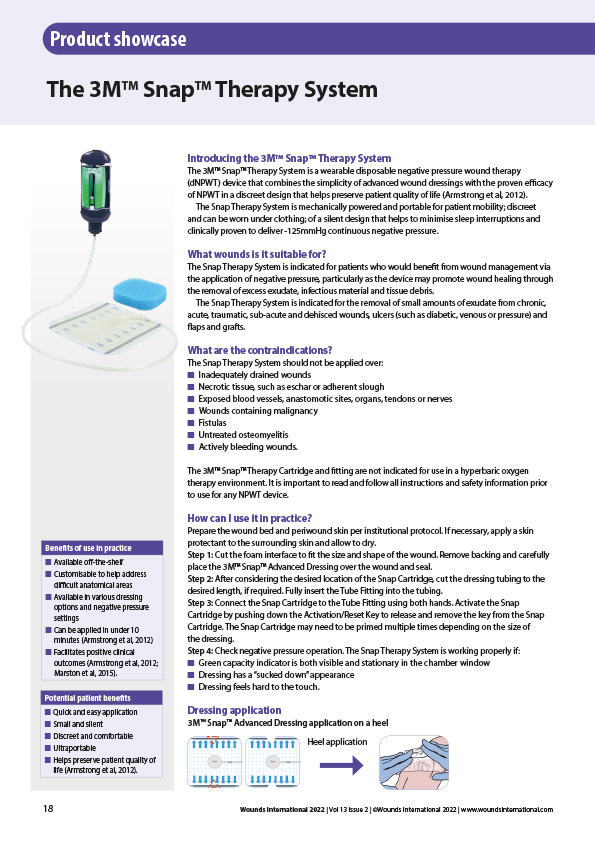
The 3M™ Snap™ Therapy System is a wearable disposable negative pressure wound therapy (dNPWT) device that combines the simplicity of advanced wound dressings with the proven efficacy of NPWT in a discreet design that helps preserve patient quality of life (Armstrong et al, 2012). The Snap Therapy System is mechanically powered and portable for patient […]
The role of VR technology in wound management and education

As technology transforms all sectors in healthcare, there is a need for innovation in learning and professional development. Use of technology such as virtual reality in medical training allows higher levels of interactivity, and the ability to rehearse clinical procedures and refine relevant skills (Herur-Raman, 2021). The new HARTMANN Virtual Reality Wound Care Simulation Training […]


